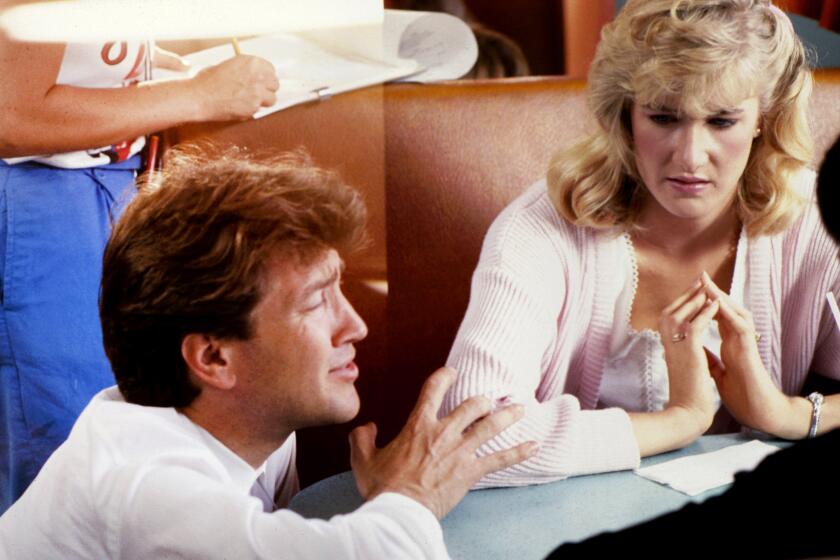Why Can’t L.A. Have a Major League Film Festival? : Commentary : In This Company Town, It’s About Time for Company to Get Behind the Business
- Share via
The late director George Cukor had just returned from the New York Film Festival in 1970 and he couldn’t get the question out of his mind: Why had Hollywood, the movie capital of the planet, allowed New York to preempt it as host of America’s most prestigious celebration of film?
The answer seems simple now, considering the financial failure of Filmex and the step-child status of the AFI/LA FilmFest that has replaced it. Hollywood isn’t very interested in films other than its own. It is, in that sense, a tight company town whose inside players routinely attend world premieres in private screening rooms, their pictures kept a safe distance from public and critical scrutiny until the marketing plan is executed.
But to Cukor, then the chairman of the Academy of Motion Pictures Arts & Sciences’ foreign language film committee, the absence of a major film festival in Los Angeles was a disgrace, and he hoped to get the academy to do something about it.
Cukor first proposed simply piggy-backing the New York Film Festival, hauling the entire program to Los Angeles as soon as it was packed up in New York. The New York organizers liked the idea of having a two-city budget with which to negotiate for films, but the logistics of a bicoastal festival quickly squelched the notion.
The academy wasn’t interested in capitalizing a new festival that might dilute the Academy Awards show, its most vital financial organ, but it was willing to provide administrative aid (its Xerox machine) for the external event that Cukor and two key recruits--the Los Angeles County Museum of Art’s Phil Chamberlin and UCLA programmer Gary Essert--eventually conceived.
In 1971, with the American Film Institute and the film schools at USC, UCLA and Cal Arts also volunteering facilities and services, the ill-fated Los Angeles International Film Exposition (Filmex) was launched.
To many movie buffs, Filmex was a roaring success. Essert, the founding director, was an energetic and passionate programmer whose everything-but-the-kitchen-sink philosophy often brought hidden treasures to Los Angeles. But during its 15-year run, Filmex captured more headlines for its financial problems and the political ruminations of its board than it did for its film discoveries, and, in 1986, three years after Essert was fired, the festival’s board voted to merge with the American Film Institute.
The AFI/LA FilmFest that begins its third year Thursday has grown to about two-thirds the size of Filmex. This year’s schedule includes about 120 films from more than 40 countries. But a film festival that includes a tribute to a director (Leonard Nimoy) whose first film (“Star Trek IV”) is less than 5 years old holds little hope for fulfilling George Cukor’s dream.
Cukor’s dream, if anything, was modest. All he wanted was a festival that would bring important international works to Los Angeles and at least link Hollywood with an arts consciousness. Filmex might have exceeded that goal, had it been well-capitalized and efficiently run. Why, naive out-of-towners might ask, don’t the cash-rich studios ante up whatever it takes to keep a major festival solvent?
“The only reason (Los Angeles) doesn’t have the biggest festival in the world is the lack of support on the part of the industry,” says Ron Haver, director of the film department at the Los Angeles County Museum of Art. “This is a company town and the attitude is, ‘What do we need a festival for?’ The industry is only interested in its own films. There’s the feeling that film festivals are elitist and that there’s nothing in it for them.”
Essert, now the director of the under-construction American Cinematheque, says the industry was supportive of Filmex, at least in supplying films for galas and in responding to fund-raising events. But the difficulties that the American Cinematheque itself has had in raising the $10 million originally budgeted for the construction of video and film facilities speaks to the indifference of generic Hollywood toward non-commercial movie enterprises.
Haver believes that even if the AFI/LA FilmFest had a program to rival New York’s, no one would acknowledge it.
“New York is where most of the influential critics are, and even if you put on a festival so big they couldn’t ignore it, they would still look down their noses at it,” he says.
Perhaps Cukor’s problem 19 years ago was in not being ambitious enough . It is typical of L.A.’s cultural inferiority complex that we would look to New York for the standard, and to the New York critics for judgment. But in fact, the festival that Los Angeles should have challenged was Cannes.
To Americans, the Cannes Film Festival more often conjures images of a topless Pia Zadora bobbing in a beachfront fountain than of the premieres of great movies. But for film makers around the world, Cannes is the World Cup of Cinema. It is the place for showing films, for selling them and for celebrating them.
The only city that could possibly put on a better show is Los Angeles. We have better weather, better theaters, a lot more history, and enough pre-printed deal forms to put the world in development.
It would be this simple, and this complex. Take all of the major film events that are currently held in Los Angeles in the first quarter of the year, add a major international film competition, and consolidate them into one festival under one administrative czar (Peter Ueberroth, listen up!). Schedule it over a month and have it culminate with the Academy Awards.
Check these events in what would have to be called the Los Angeles International Super Fest:
Competition: Just like Cannes, the featured series of the L.A. Super Fest would be a major international competition (no Gold Palm award here; we’ll give platinum), with both prestige and dough (nothing like a $100,000 prize to divert a Cannes-bound film to L.A.). There would also be a competition for American independent film makers for movies that were at least partially financed with grant money and made for less than, say, $3 million. The publicity would encourage the donors and the exposure would give many of the films a chance of a distribution deal.
Guild Series: Most of the trade guilds currently nominate and select winners for best achievement awards. The process would be brought into the festival, with seminars and tributes organized to promote the specific contributions of each trade--the cinematographers, sound and film editors, writers and so on. Would people attend a series of movies shot by cinematographer Sven Nykvist, who would be on hand to explain his decisions? Would they go to a six-pack of films written by writer Robert Towne and hear him discuss each one afterwards? Where do we sign up?
American Film Market: This 9-year-old event, organized to bring foreign film buyers into contact with American sellers, has outgrown two hotels and is already challenging Cannes’ market in gross sales. It would become part of the festival. Some of its mostly action-genre films would be booked into local theaters and series tickets would be sold. The sellers would set up their booths in a convention hall, where fans with Super Fest tickets could browse through posters and buttons and see trailers of the films being peddled.
Foreign Language Film Series: Foreign language films that are submitted to the motion picture academy for Oscar consideration would be shown as one series. The series is now held each year for academy members on the foreign language committee; it would just be opened to the public. The nominations process would be unchanged and what is now an obscure awards category on Oscar night would benefit from the media exposure. Tributes to foreign film directors could be held in conjunction with the series, as well as seminars where the foreign film makers could exchange ideas and cultural film differences with their American counterparts--in public forums.
Documentary and Short Subject Series: Academy screenings of entries in these blind-date categories on the Oscar office pool would also be opened to the public. Some of these films are never shown publicly, which is a disgrace in itself, and the exposure would create an awareness that might create a commercial after (Oscar) life.
Career Achievement Award: The academy occasionally pays tribute to an old-timer on Oscar night and it often sinks the show. The better idea is the American Film Institute’s Life Achievement Award, an A-list party that turns its powerful guests into sardines each year at the Beverly Hilton Hotel. This would be moved to a larger venue and would culminate a tribute that would also include a retrospective series of the guest-of-honor’s films. (The taped tribute could be shown the same night as the Oscars, in the time spot where Barbara Walters now asks current super stars what kinds of trees they would like to be.)
Academy Awards Series: As part of the massive hype that attends the Oscars, the academy could organize its own series of Academy Award-winning films for the festival, and include a feature-length compilation of Oscar’s best and/or most embarrassing moments. The man who streaked the 1973 awards show always gets a big laugh. (“Just think,” said a composed David Niven after the gasps subsided, “the only laugh that man will probably ever get is for stripping and showing off his shortcomings.”)
----
There are endless potential attractions that could be added. The studios could premiere movies with old-fashioned showmanship, with searchlights and decked-out stars gliding across red carpets. Some exhibition mogul could reinstitute Sid Grauman’s ritual of hand and footprints in cement. Army Archerd could warm up for the Oscars by asking the films’ stars, “Have you ever had a night like this before?”
In Los Angeles, glamour is part of the landscape. You will see more celebrities at the Beverly Center on a good day than you will at Cannes in a season.
The lesson from Cannes is that festivals don’t have to be dignified to be important. Movies can be both fun and smart, entertainment and art, and a good festival is one that promises and delivers everything.
Cannes is unique in that it crams dozens of tributes, hundreds of films and thousands of fans into an area that can be covered on foot, without disturbing the throngs of locals tanning their privates on the beach. A Los Angeles Super Fest would be geographically spread out, and wouldn’t take advantage of the surf. But it would fill every hotel between Santa Barbara and San Diego for a few weeks each year, not to mention every theater, and even if Pia Zadora refused to bob in the Century City fountain, it couldn’t be ignored.
New York’s critics might still look down their noses at it, but they’d have to look up to do it.
More to Read
Only good movies
Get the Indie Focus newsletter, Mark Olsen's weekly guide to the world of cinema.
You may occasionally receive promotional content from the Los Angeles Times.










